Section 1: Agency overview and resources
1.1 Strategic direction
There has been no significant change to the strategic direction of the Australian Competition and Consumer Commission (ACCC) from that outlined in the Portfolio Budget Statements 2013-14 (pages 85-86).
The ACCC is seeking an additional $23.8 million in departmental outputs through Appropriation Bill (No. 3) 2013-14. This comprises an additional $24.4 million which is offset by savings of $0.5 million.
The additional $24.4 million relates to:
- $2.0 million for the Repeal of the Carbon Tax — abolishing other measures measure as outlined in the Mid-Year Economic and Fiscal Outlook 2013-14; and
- $22.4 million for additional funding for the ACCC which was agreed after the Mid-Year Economic and Fiscal Outlook 2013-14.
The savings of $0.5 million relates to:
- $0.1 million for the Public Service efficiencies measure as outlined in Budget Paper No. 2, Budget Measures 2013-14;
- $0.1 million for Reforms to APS management and efficient procurement of agency software measure as outlined in the Economic Statement 2013; and
- $0.3 million for targeted information and communications technology savings.
The ACCC is also seeking an additional $14.3 million in equity injections through Appropriation Bill (No. 4) 2013-14. This comprises:
- $5.5 million for additional funding for the ACCC which was agreed after the Mid-Year Economic and Fiscal Outlook 2013-14; and
- $8.8 million for the ACCC's Litigation Contingency Fund.
1.2 Agency resource statement
Table 1.1 shows the total resources from all origins. The table summarises how resources will be applied by outcome and by administered and departmental classification.
Table 1.1: Australian Competition and Consumer Commission resource statement —
additional estimates for 2013-14 as at Additional Estimates February 2014
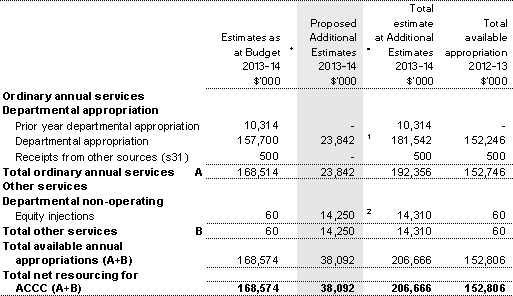
1. Appropriation Bill (No. 3) 2013-14.
2. Appropriation Bill (No. 4) 2013-14.
1.3 Agency measures table
Table 1.2 summarises new Government measures taken since the 2013-14 Budget.
Table 1.2: Agency measures since Budget
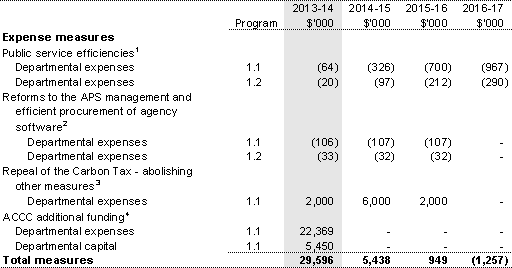
1. This measure was included in Budget Paper No. 2, Budget Measures 2013-14.
2. This measure was included in the Economic Statement 2013.
3. This measure was included in the Mid-Year Economic and Fiscal Outlook 2013-14.
4. This was agreed after the Mid-Year Economic and Fiscal Outlook 2013-14.
1.4 Additional estimates and variations
Table 1.3 details the additional estimates resulting from new measures since the 2013-14 Budget. Table 1.4 details the additional estimates resulting from other variations since the 2013-14 Budget.
Table 1.3: Additional estimates and variations to outcomes from measures since 2013-14 Budget
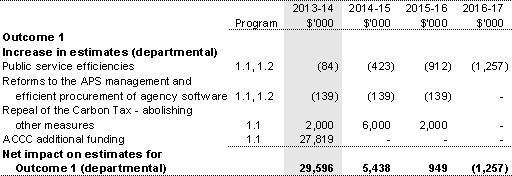
Table 1.4: Additional estimates and variations to outcomes from other variations
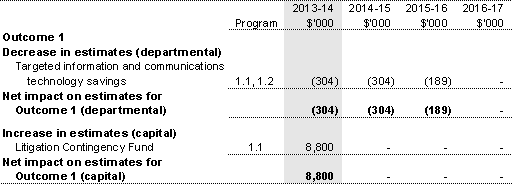
1.5 Breakdown of additional estimates by Appropriation Bill
The following table details the additional estimates sought for the ACCC through Appropriation Bill No. 3.
Table 1.5: Appropriation Bill (No. 3) 2013-14
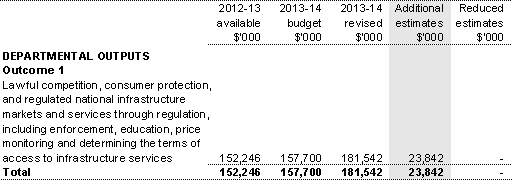
1.6 Breakdown of additional estimates by Appropriation Bill
The following table details the additional estimates sought for the ACCC through Appropriation Bill No. 4.
Table 1.6: Appropriation Bill (No. 4) 2013-14

Section 2: Revisions to agency outcomes and planned performance
2.1 Resources and performance information
There has been no change to outcomes or the outcome strategy for the ACCC from that included in the Portfolio Budget Statements 2013-14 (pages 89).
Table 2.1: Budgeted expenses for Outcome 1
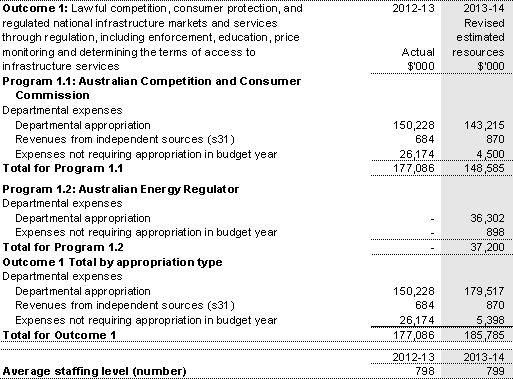
Note: Program 1.2 is effective from 2013-14. The AER was previously reported under Program 1.1.
Program 1.1: Australian Competition and Consumer Commission
There has been no change to program objectives, deliverables or key performance indicators for the ACCC from that included in the Portfolio Budget Statements 2013-14.
Table 2.2.1: Program expenses

Program 1.2: Australian Energy Regulator
There has been no change to program objectives, deliverables or key performance indicators for the AER from that included in the Portfolio Budget Statements 2013-14.
Table 2.2.2: Program expenses

Section 3: Explanatory tables and budgeted financial statements
3.1 Explanatory tables
3.1.1 Estimates of special account flows
Special accounts provide a means to set aside and record amounts used for specified purposes. Table 3.1.2 shows the expected additions (receipts) and reductions (payments) for each account used by the ACCC.
Table 3.1.2: Estimates of special account cash flows and balances
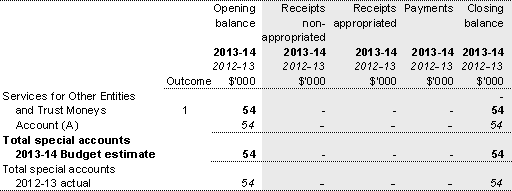
(A) Administered
3.2 Budgeted financial statements
3.2.1 Analysis of budgeted financial statements
The ACCC is budgeting for a departmental breakeven operating result for 2013-14 after adjusting for non-appropriated expenses of depreciation and amortisation.
3.2.2 Budgeted financial statements
Departmental financial statements
Table 3.2.1: Budgeted departmental comprehensive income statement (Showing Net Cost of Services)
(for the period ended 30 June)
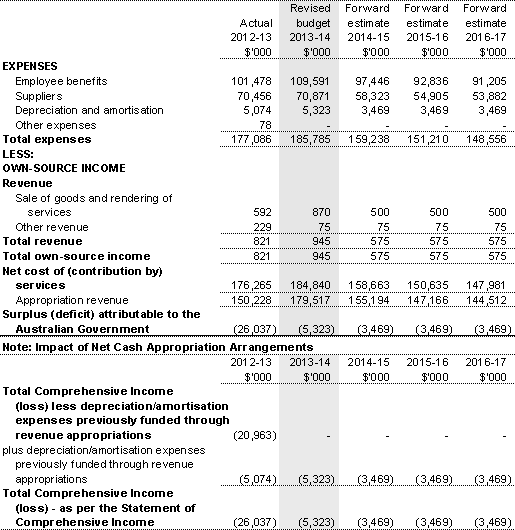
Prepared on Australian Accounting Standards basis.
Table 3.2.2: Budgeted departmental balance sheet
(as at 30 June)
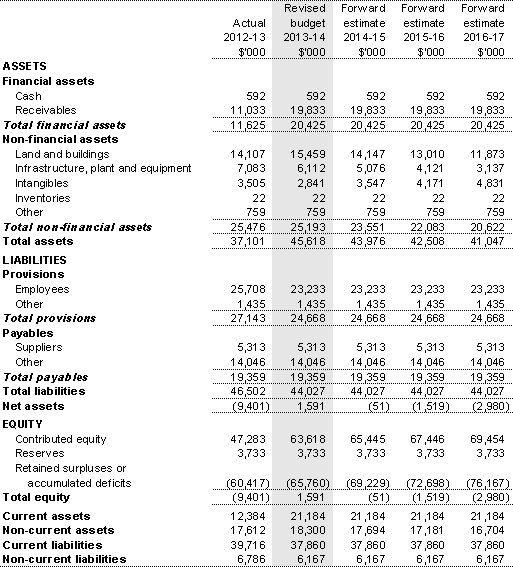
Prepared on
Australian Accounting Standards basis.
Table 3.2.3: Budgeted departmental statement of cash flows
(for the period ended 30 June)
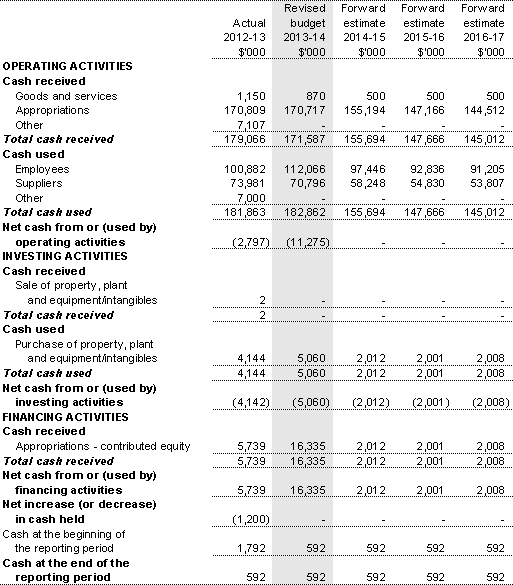
Prepared on Australian Accounting Standards basis.
Table 3.2.4: Departmental statement of changes in equity — summary of movement
(budget year 2012-13)
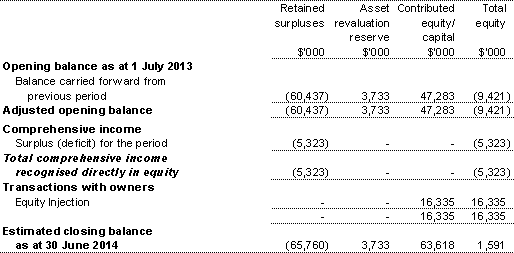
Prepared on Australian Accounting Standards basis.
Table 3.2.5: Departmental capital budget statement
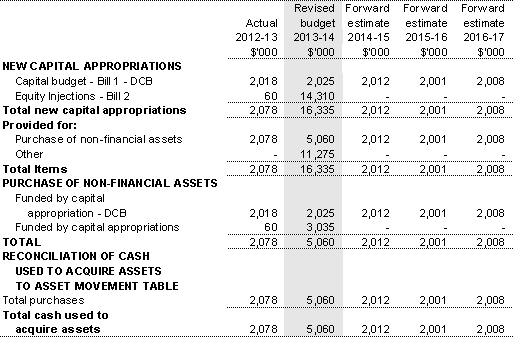
Prepared on Australian Accounting Standards basis.
Table 3.2.6: Statement of asset movements — Departmental (2013-14)
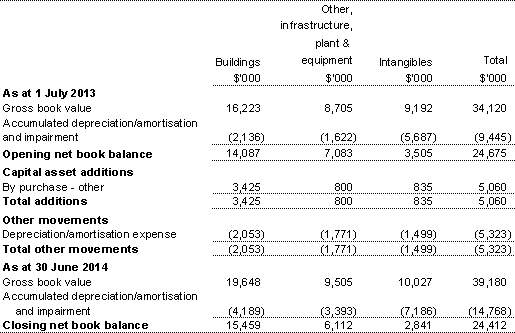
Prepared on Australian Accounting Standards basis.
Table 3.2.7: Schedule of budgeted income and expenses administered on behalf of Government
(for the period ended 30 June)
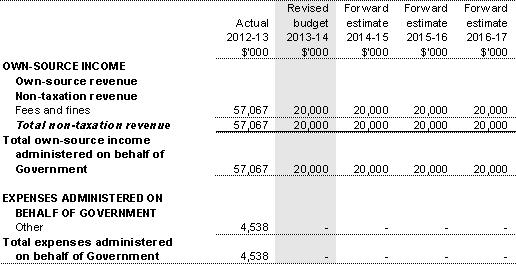
Prepared on Australian Accounting Standards basis.
Table 3.2.8: Schedule of budgeted assets and liabilities administered on behalf of Government
(as at 30 June)
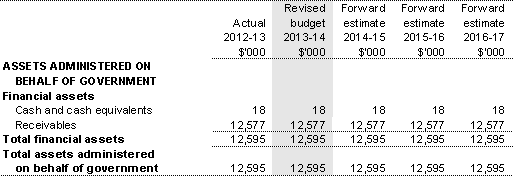
Prepared on Australian Accounting Standards basis.
Table 3.2.9: Schedule of budgeted administered cash flows
(for the period ended 30 June)
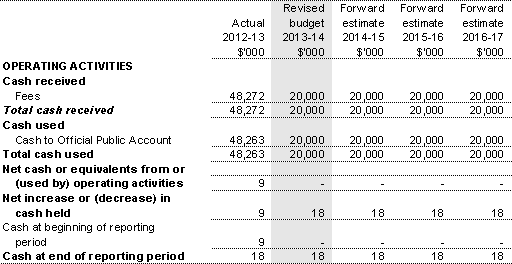
Prepared on Australian Accounting Standards basis.
3.2.3 Notes to the financial statements
Accounting policy
The budgeted financial statements have been prepared on an accrual accounting basis having regard to statements of accounting concepts, and in accordance with:
- the Government's financial budgeting and reporting framework; and
- Australian Accounting Standards and Interpretations issued by the Australian Accounting Standards Board.
Departmental and administered items
Agency assets, liabilities, revenues and expenses are those items that are controlled by the ACCC that are used by the ACCC in producing its program and include:
- computers, plant and equipment and building fitout used in providing goods and services;
- liabilities for employee entitlements;
- revenue from appropriations or independent sources in payment for the departmental program; and
- employee, supplier and depreciation expenses incurred in providing agency program.
Administered items are those items incurred in providing programs that are controlled by the Government and managed, or oversighted by the ACCC on behalf of the government. Administered revenues include fees and fines.
Departmental revenue
Revenue from government represents the purchase of outputs from the ACCC by the Government and is recognised to the extent that it has been received into the ACCC's bank account.
Revenue from other sources, representing sales from goods and services, is recognised at the time that it is imposed on customers.
Departmental expenses — employees
Payments and net increases in entitlements to employees for services rendered in the financial year.
Departmental expenses — suppliers
Payments to suppliers for goods and services used in providing agency programs.
Departmental expenses — depreciation and amortisation
Depreciable property, plant and equipment, buildings and intangible assets are written-off to their estimated residual values over their estimated useful life, using the straight-line calculation method.
Departmental assets — financial assets
The primary financial asset relates to receivables. Financial assets are used to fund the ACCC's capital program, employee entitlements, creditors and to provide working capital.
Departmental assets — non-financial assets
These items represent future benefits that the ACCC will consume in producing outputs. The reported value represents the purchase paid less depreciation incurred to date in using the asset.
Departmental liabilities — provisions and payables
Provision has been made for the ACCC's liability for employee entitlements arising from services rendered by employees. The liability includes unpaid annual leave and long service leave.
Provision has also been made for unpaid expenses as at balance date.